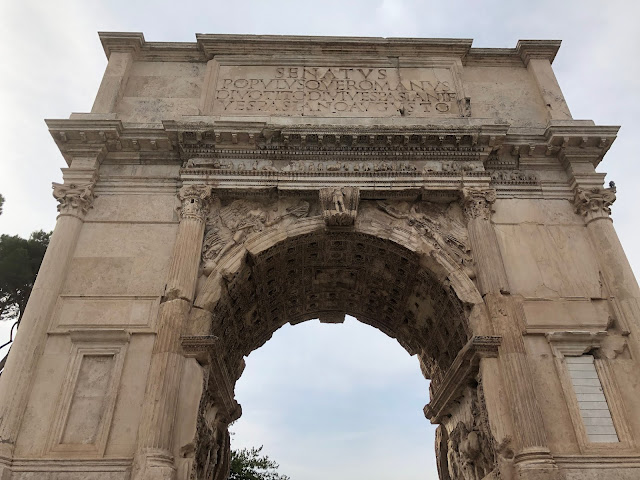【ローマ】フォロ・ロマーノと古代ローマ① Roma - Foro Romano and Ancient Roma : Part-1
コロッセオの前の広場から、西の方に少し坂を上がると、フォロ・ロマーノへの入り口がある。
コロッセオと並ぶ、ローマの大観光地の1つであるフォロ・ロマーノへの入り口には、長い列ができていた。
セキュリティ・チェックを受けて、ゲートを抜けると、いきなり巨大なティトゥスの凱旋門が現代の観光客を出迎える。
ティトゥス帝は、コロッセオの建設を始めた父親のウェスパシアヌスを継いで79年に皇帝になった。コロッセオは、その翌年の80年に完成した。
しかし、ティトゥス帝は81年に病のために亡くなってしまった。79年にヴェスヴィオ火山が噴火して、その影響でローマにも火災が発生し、ティトゥスはその復興にあたっていた。
この凱旋門は、ティトゥスの弟で皇帝の座を継いだドミティアヌス帝によって、ティトゥス帝のユダヤ戦役の功績を讃えるために建設された。
ティトゥスは、父親のウェスパシアヌスの補佐としてイスラエルの地に赴き、途中で父親が皇帝に選出されてローマに戻ってからも現地に残りユダヤ人の反乱の鎮圧まで指揮した。
この凱旋門の勇壮な姿は、パリの凱旋門など、その後の凱旋門のモデルとなった。
From the square in front of the Colosseum, go up a little west to the west and you will find the entrance to the Roman Forum.
There was a long line at the entrance to the Roman Forum, one of Rome's major tourist destinations, alongside the Colosseum.
After undergoing a security check and passing through the gate, the huge Arch of Titus suddenly welcomes modern tourists.
Emperor Titus became emperor in 79, succeeding his father Vespasian, who began the construction of the Colosseum. The Colosseum was completed in 80, the following year.
However, Emperor Titus died of illness in 81. The eruption of Mount Vesuvius in 79 caused a fire in Rome, and Titus was in the process of rebuilding it.
The Arc de Triomphe was built by Titus' younger brother, Emperor Domitian, who succeeded the Emperor, to honor Titus's achievements in the Jewish-Roman campaign.
Titus traveled to the land of Israel as an assistant to his father Vespasian, who remained there even after his father was elected emperor and returned to Rome, commanding the suppression of the Jewish rebellion.
This magnificent figure of the Arc de Triomphe became a model for the subsequent Arc de Triomphe, such as the Arc de Triomphe in Paris.
ティトゥスの凱旋門を潜ると、目の前の巨大な空間が広がっている。この辺りが古代ローマの政治の中心であったと言われている。
少し先に進むと、右手にマクセンティウスのバジリカが見えてくる。306年にマクセンティウス帝が建設を初めて、コンスタンティヌス帝によって完成された建物だ。
ローマの始まりは神話によって彩られているが、紀元前500年頃には共和制の都市国家になっていた。
その後、ローマはカルタゴとの戦いに勝って地中海の覇者になり、紀元前27年には帝政に移行し、五賢帝の時代には地中海を中心にヨーロッパやアフリカ、中東にまでその領土を広げた。
東西分裂の後、480年には西ローマ帝国は滅亡するが、コンスタンチノープルを首都とする東ローマ帝国は、オスマン帝国によって1453年に滅ぼされるまで続いた。
古代ローマは、共和制の誕生から東ローマ帝国の滅亡まで、およそ2000年間も続いたことになる。
これほど巨大帝国が、これほど長い間続いた例は、人類史上他にない。
東ローマが滅亡してから、まだわずか500年ほどしか経っていないのだ。
When you dive down the Arch of Titus, you will find a huge space in front of you. It is said that this area was the political center of ancient Rome.
If you go a little further, you will see Maxentius's Basilica on your right. The building was first built by Emperor Maxentius in 306 and completed by Emperor Constantine.
The beginnings of ancient Rome are colored by mythology, but around 500 BC it became a republican city-state.
After that, Rome won the battle with Carthage and became the champion of the Mediterranean Sea. ..
After the East-West Schism, the Western Roman Empire was destroyed in 480, but the Byzantine Empire, whose capital was Constantinople, continued until it was destroyed by the Ottoman Empire in 1453.
Ancient Rome lasted for about 2000 years, from the birth of the republic to the fall of the Byzantine Empire.
No other empire in human history has lasted such a huge empire for such a long time.
Only about 500 years have passed since the fall of Byzantine Empire.
フォロ・ロマーノをさらに進むと、右手にロムルスの神殿と、アントニヌスとファウスティーナの神殿が見えてくる。
ロムルスの神殿は、マクセンティウス帝が幼くして亡くなった息子のロムルスのために建てた神殿だが、建設中にマクセンティウス自身も戦争で亡くなったために、未完成のまま残されたと言われている。
Proceeding further on the Roman Forum, you will see the temple of Romulus and the temples of Antoninus and Faustina on your right.
The temple of Romulus was built by Emperor Maxentius for his son Romulus, who died at an early age, but it is said that Maxentius himself died in the war during construction and was left unfinished.
アントニヌスとファウスティーナの神殿は、アントニヌス・ピウス帝が、141年に亡くなった皇后ファウスティーナのために建てた神殿。アントニヌス・ピウス自身も死後にここに祀られた。






コメント
コメントを投稿